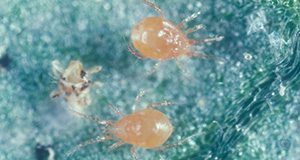Abstract
The aim of this 9-page document is to inform Florida strawberry producers and Extension personnel on the compatibility of registered miticides and insecticides with commercially available predatory mites used as biological controls. Written by Braden Evans, Karol Krey, and Justin Renkema and published by the UF/IFAS Entomology and Nematology Department, August 2018.
http://edis.ifas.ufl.edu/in1216
References
Mossler, M. 2012. Florida Crop/Pest Management Profiles: Strawberry. CIR1239. Gainesville: Institute of Food and Agricultural Sciences. http://edis.ifas.ufl.edu/pi037
Marinosci, C., S. Magalhães, E. Macke, M. Navajas, D. Carbonell, C. Devaux, and I. Olivieri. 2015. "Effects of host plant on life-history traits in the polyphagous spider mite Tetranychus urticae." Ecology and Evolution. 5: 3151-3158 https://doi.org/10.1002/ece3.1554
Fasulo, T. R. and H. A. Denmark. 2009. Twospotted spider mite. EENY150. Gainesville: Institute of Food and Agricultural Sciences. http://edis.ifas.ufl.edu/in307
Arthropod Pesticide Resistance Database. "Tetranychus urticae." https://www.pesticideresistance.org/display.php?page=species&arId=536.
Van Leeuwen, T., J. Vontas, A. Tsagkarakou, W. Dermauw, and L. Tirry. 2010. "Acaricide resistance mechanisms in the two-spotted spider mite Tetranychus urticae and other important Acari: a review." Insect Biochemistry and Molecular Biology. 40(8): 563-572. https://doi.org/10.1016/j.ibmb.2010.05.008
Ashihara, W., T. Hamamura, and N. Shinkaji. 1978. "Feeding reproduction, and development of Phytoseiulus persimilis Athias-Henriot (Acarina:Phytoseiidae) on various food substances." Bull. Fruit Tree Res. Stn. Ser. E. 2: 91-98.
Van den Boom, C. E. M., T. A. Van Beek, and M. Dicke. 2002. "Attraction of Phytoseiulus persimilis (Acari: Phytoseiidae) towards volatiles from various Tetranychus urticae-infested plant species." Bulletin of Entomological Research. 92(6): 539-546. https://doi.org/10.1079/BER2002193
Chant, D. A. 1961. "An experiment in biological control of Tetranychus telarius (L.) (Acarina: Tetranychidae) in a greenhouse using the predacious mite Phytoseiulus persimilis Athias-Henriot (Phytoseiidae)." The Canadian Entomologist. 93(6): 437-443. https://doi.org/10.4039/Ent93437-6
Laing, J. E. and C. B. Huffaker. 1969. "Comparative studies of predation by Phytoseiulus persimilis Athias-Henriot and Metaseiulus occidentalis (Nesbitt) (Acarina: Phytoseiidae) on populations of Tetranychus urticae koch (Acarina: Tetranychidae)." Researches on Population Ecology. 11(1): 105-126. https://doi.org/10.1007/BF02514514
McMurtry, J. A. 1977. "Some predaceous mites [Phytoseiidae] on citrus in the Mediterranean region." BioControl. 22(1): 19-30. https://doi.org/10.1007/BF02372986
McMurtry, J.A. and A. B. Croft. 1997. "Life-styles of Phytoseiidae mites and their roles in biological control." Annual Review of Entomology. 42: 291-321. https://doi.org/10.1146/annurev.ento.42.1.291
Hoffmann, M. P. and A. C. Frodsham. 1993. Natural Enemies of Vegetable Insect Pests. Ithaca: Cornell University Cooperative Extension. 63 pp.
Cross, J. V. 1984. "Biological control of two‐spotted spider mite (Tetranychus urticae) by Phytoseiulus persimilis on strawberries grown in walk‐in plastic tunnels, and a simplified method of spider mite population assessment." Plant Pathology. 33(3): 417-423. https://doi.org/10.1111/j.1365-3059.1984.tb01337.x
Wysoki M. 1985. "Outdoor crops." In: World Crop Pests. Spider Mites. Their Biology, Natural Enemies and Control, Vol. 1B. Edited by W. Helle and M. W. Sabelis. pp. 375-384. Elsevier, Amsterdam.
Sznajder, B., M. W. Sabelis, and M. Egas. 2011. "Innate Responses of the Predatory Mite Phytoseiulus Persimilis to a Herbivore-Induced Plant Volatile." Experimental & Applied Acarology. 54: 125-138. https://doi.org/10.1007/s10493-011-9430-z
McMurtry, J. A. 1982. "The use of phytoseiids for biological control: progress and future prospects." In Recent advances in knowledge of the Phytoseiidae. pp. 23-48.
Rhodes, E. M. and O. E. Liburd. 2006. "Evaluation of predatory mites and Acramite for control of twospotted spider mites in strawberries in north central Florida." Journal of Economic Entomology. 99(4): 1291-1298. https://doi.org/10.1093/jee/99.4.1291
Schausberger, P. and A. Walzer. 2001. "Combined versus single species release of predaceous mites: predator-predator interactions and pest suppression." Biological Control. 20(3): 269-278 https://doi.org/10.1006/bcon.2000.0908
Castagnoli, M., M. Liguori, and S. Simoni. 1999. "Effect of two different host plants on biological features of Neoseiulus californicus (McGregor)." International Journal of Acarology. 25(2):145-150. https://doi.org/10.1080/01647959908683626
Castagnoli, M. and L. Falchini. 1993. "Suitability of Polyphagotarsonemus latus (Banks) (Acari Tarsonemidae) as prey for Amblyseius californicus (McGregor) (Acari Phytoseiidae)." Redia. 76: 273-279.
Croft, B. A., L. N. Monetti, and P. D. Pratt. 1998. "Comparative life histories and predation types: are Neoseiulus californicus and N. fallacies (Acari: Phytoseiidae) similar type II selective predators of spider mites." Environmental Entomology. 27: 531-538. https://doi.org/10.1093/ee/27.3.531
Croft, B. A. 1990. "Developing a philosophy and program of pesticide resistance management." In Pesticide resistance in arthropods. pp. 277-296. https://doi.org/10.1007/978-1-4684-6429-0_11
Blümel, S. 1999. "Susceptibility of Neoseiulus californicus to pesticides in the laboratory compared to other predatory mites." In October meeting of the IOBC/WPRS WG Pesticides and Beneficial Organisms. 26:30.
Castagnoli, M., M. Liguori, S. Simoni, and C. Duso. 2005. "Toxicity of some insecticides to Tetranychus urticae, Neoseiulus californicus and Tydeus californicus." BioControl. 50(4): 611-622. https://doi.org/10.1007/s10526-004-8121-7
Rhodes, E. M. and O. E. Liburd. 2015. Neoseiulus californicus (McGregor) (Arachnida: Acari: Phytoseiidae). EENY359. Gainesville: Institute of Food and Agricultural Sciences. http://edis.ifas.ufl.edu/in639
Gilstrap, F. E. and D. D. Friese. 1985. "The predatory potential of Phytoseiulus persimilis, Amblyseius californicus, and Metaseiulus occidentalis (Acarina: Phytoseiidae)." International Journal of Acarology. 11(3): 163-168. https://doi.org/10.1080/01647958508683410
Liu R., T. W. Nyoike, and O. E. Liburd. 2016. "Evaluation of site-specific tactics using bifenazate and Neoseiulus californicus for management of Tetranychus urticae (Acari: Tetranychidae) in strawberries." Experimental and Applied Acarology. 70: 189-204. https://doi.org/10.1007/s10493-016-0073-y
Fraulo, A.B. and O. E. Liburd. 2007. "Biological control of twospotted spider mite, Tetranychus urticae, with predatory mite, Neoseiulus californicus, in strawberries." Experimental and Applied Acarology. 43(2): 109. https://doi.org/10.1007/s10493-007-9109-7
Cross, J. V., M. A. Easterbrook, A. M. Crook, D. Crook, J. D. Fitzgerald, P. J. Innocenzi, C. N. Jay, M. G. Solomon. 2001. "Review: Natural enemies and biocontrol of pests of strawberry in northern and central Europe." Biocontrol Science and Technology. 11(2): 165-216. https://doi.org/10.1080/09583150120035639
This work is licensed under a Creative Commons Attribution-NonCommercial-NoDerivs 4.0 International (CC BY-NC-ND 4.0) license.

